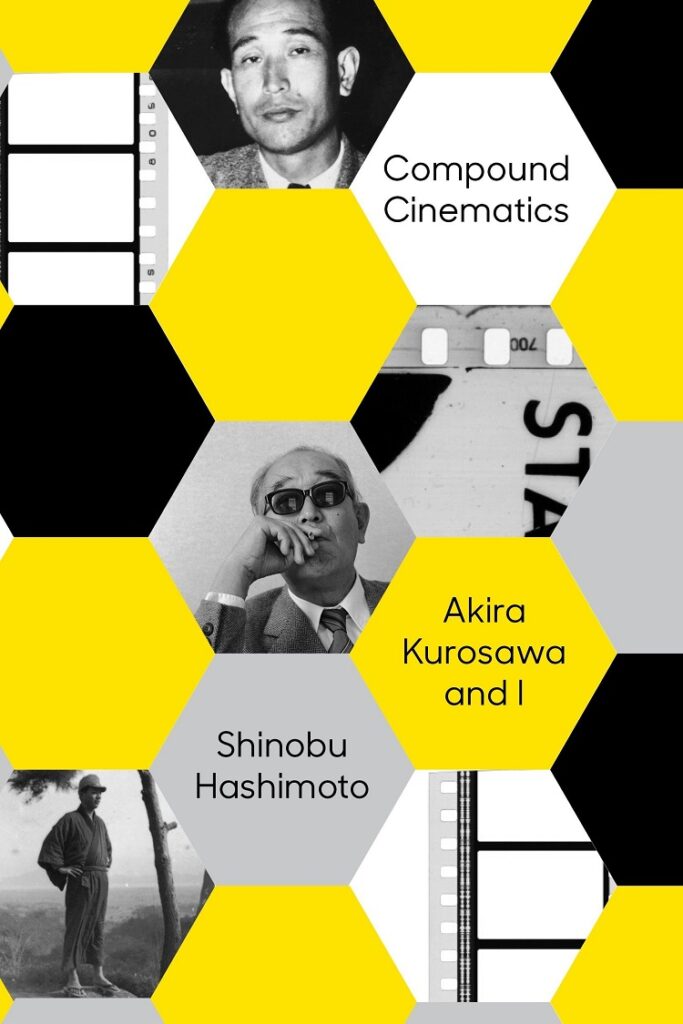
Shinobu Hashimoto wrote the screenplays to Akira Kurosawa’s Rashomon, Ikiru and The Seven Samurai. If you are keeping score, that’s three of the greatest films in the history of films. He wrote several more films with Kurosawa including Throne of Blood and The Hidden Fortress plus dozens more for other directors. Originally published in 2006, Compound Cinematics: Akira Kurosawa and I is finally being made available in English by Vertical Inc. Having not heard of the book (or to be honest, the writer though I’m a great lover of Kurosawa) until about a week ago, I can’t say it was worth the wait. But retroactively, it kind of was.
Part memoir, part screenwriting textbook, part treatise on the art of filmmaking, Compound Cinematics is a fascinating look inside the mind of one of the great screenwriters and his collaborations with one of the world’s greatest directors. The book is divided into several sections. He discusses how he became a screenwriter. He goes into great detail on his collaboration with Kurosawa writing Rashomon, Ikiru, and The Seven Samurai, and quite a bit of detail on the other times they worked together. There is a short, but important section where he essentially writes a thesis on the best way to write a screenplay. Lastly, there is some discussion on the last few years of Kurosawa’s life and some (rather unflattering) remarks about his late-period films.
Hashimoto got into the screenwriting game (though at first he is what he refers to as a scenarist – that is writing essentially a short story including plot details and characterizations upon which the actual screenplay will draw from) on a whim. While convalescing after the war, a fellow soldier handed him a movie magazine which contained a scenario in it. Deciding he could do better, he wrote his own scenario on the commute to and from work and sent it to famed Japanese filmmaker Mansaku Itami. Liking what he read, Itami took Hashimoto as an apprentice and taught him for several years. It was here he started on Rashomon and got connected with Kurosawa.
The famed director is credited as co-writer on nearly all of his films. Though a talented writer himself, he seems to have enjoyed the collaborative process. He was a very meticulous writer as Hashimoto notes they would spend a great deal of time doing research on a project and countless hours discussing the story and characters before ever writing a word of the screenplay. For those early films, the two would sit at a table, each writing pages then handing them to a third member of the team who would either give his approval or would suggest improvements.
One of the more fascinating chapters in the book is a discussion about a film that was never made. Before creating the Seven Samurai, they were working on a film about a day in the life of one samurai who would commit suicide by the film’s end. They intended it to be made as realistically as possible, chronicling what your average samurai would encounter during an average day. Unfortunately (or fortunately depending on your point of view – and it certainly is mine since this failure led to the Seven Samurai), they could not determine satisfactorily if samurais of that period would sit down for a noontime meal. Yep, they cancelled production on a movie over lunch. Hashimoto eventually did make that film, Hara Kiri with director Masaki Kobayashi.
After The Seven Samurai, Kurosawa changed strategies and a group of writers would each write the same part of the story and then they’d vote on which one was best. It was a page-by-page competition and one that Hashimoto was resentful of. He critiques this method pretty harshly, saying that he prefers the more collaborative approach of those early films. He has negative things to say about several of Kurosawa later films including Kagemusha and Ran, both of which he considers failures due to this new method of writing. He spares no punches for anyone, including Steven Spielberg. After viewing Jaws, he notes that he’ll never watch another film by Spielberg as there is no possible way he’ll be able to best that film.
Compound Cinematics: Akira Kurosawa and I is a fascinating look into the art of one of the greatest directors by a man who worked closely with him. Though they wrote numerous films together and collaborated closely for years, Hashimoto never delves very far into who Kurosawa was as a person. It’s unclear as to whether this is because Kurosawa was a closely guarded figure, or if Japanese culture at the time dictated that the working relationships never got too personal, or if Hashimoto just doesn’t consider that aspect of Kurosawa’s life worth writing about. The closest we really get to that part of Kurosawa are several scenes in which the director demonstrates a very sharp temper. Whatever the reasons for not delving into the personal dealings of Kurosawa, the book gives a wealth of information on how the director prepared for his films and wrote them. For Kurosawa scholars and even just fans of his movies, these details are absolutely wonderful.
Less interesting are the writer’s thoughts on the best methods for writing. Certainly he is a well-celebrated screenwriter and he absolutely has something of import to say about the craft, but after the thrilling sections on writing with Kurosawa, his treatise feel a little self-indulgent. I suspect beginning screenwriters will find plenty to dig into there (though I’m not entirely sure anybody really writes movies collaboratively anymore, unless its by committee.) But for the sections with Kurosawa and the behind-the-scenes look at three of the world’s greatest films, this book is highly recommended.